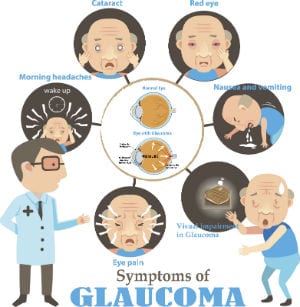Glaucoma is considered a silent disease that can ultimately rob you of your vision. Increasing your awareness of this disease, including the importance of identifying family members diagnosed with it, presents you with the opportunity to save your sight!
In most glaucoma cases, the disease is a result of your eye’s inability to properly produce and drain the body’s natural fluid called intraocular or aqueous humor. If the balance between producing and draining the fluid changes, abnormally high pressure builds up within the eye. This pressure, over time, deteriorates the optic nerve leading to irreversible blindness.
Glaucoma is particularly challenging because there are no signs or symptoms in early stages. Anyone is at risk for developing glaucoma. While more mature people have an increased risk, children can also get glaucoma. According to the Glaucoma Research Foundation, approximately 1 out of every 10,000 babies born in the United States have glaucoma.
Glaucoma comes in two common forms — primary open-angle glaucoma and angle-closure glaucoma. Each has their own unique and subtle set of symptoms, so watch out for any of these eight warning signs.

- Eye Pain – sudden eye pain and headaches behind the eyes and eyebrow are signs of late stage acute angle-closure glaucoma.
- Eye Ball Changes – with acute angle-closure glaucoma, eyeballs are red with large pupils that are nonreactive to light. Difficult to see with the naked eye. The cornea may be slightly cloudy and swollen.
- Night Halos – a rainbow-colored effect from acute angle-closure glaucoma. Night vision issues such as halos or starbursts. Blurred vision around lights. The feeling of extreme pressure and sudden blindness as the pupil opens.
- Tunnel Vision – slow narrowing of the peripheral vision causing tunnel vision, from primary open-angle glaucoma. Interrupts the edges of the field of view.
- Blurred Vision – gradual decline in sharpness of vision (or visual acuity) from acute angle-closure glaucoma. Progressing to severe blurring.
- Eye Swelling and Redness – red eyes and headaches from swollen irises due to eye pressure build-up in acute angle-closure glaucoma. (Eye redness can also occur from the chronic use of eye drops.)
- Nausea – vision is distorted causing nausea and vomiting, accompanied by severe eye pain from acute angle-closure glaucoma.
- Sudden Visual Disturbance – a sudden onset of a visual disturbance in low lighting can be from acute angle-closure glaucoma.
Gathering your family’s eye history, and updating it regularly, allows you to better manage your eye health. This is especially true when a family member has been diagnosed with glaucoma. Research studies suggest that one of the greatest risk factors for developing glaucoma is having a family history of the disease. Having a sibling with the disease increases your risk significantly. For example, if you have a brother or sister with glaucoma you have a 10 times greater chance of developing it.
There is nothing simple about glaucoma, since the disease remains silent for a long period. Over 60% of individuals, around the world, have glaucoma and don’t know it.
At your next family gathering, bring up the topic of your family history and ask others to share. Don’t forget to include discussing the medical history of family members who have passed on. Consider creating a family tree with everyone’s medical histories.
One of the most important things to detect glaucoma is to schedule regular eye exams that include testing the pressure in your eye.
Visit our website to learn more about glaucoma and schedule your eye exam with one of our highly-trained and skilled physicians that specialize in diagnosing and treating glaucoma.
Don’t lose sight of the importance of increasing, and sharing, your knowledge of glaucoma with those you love!


